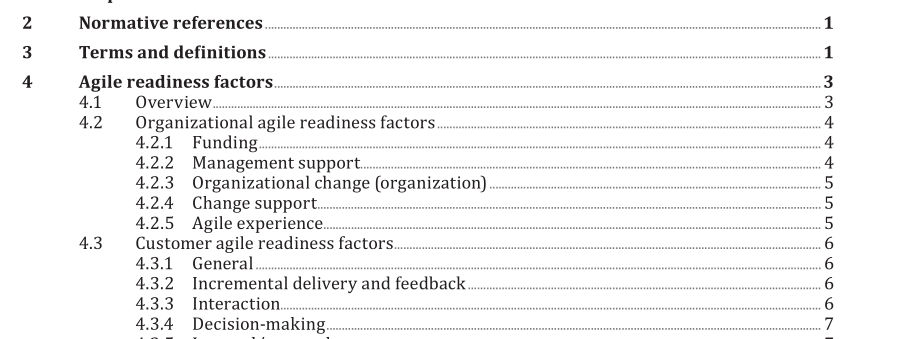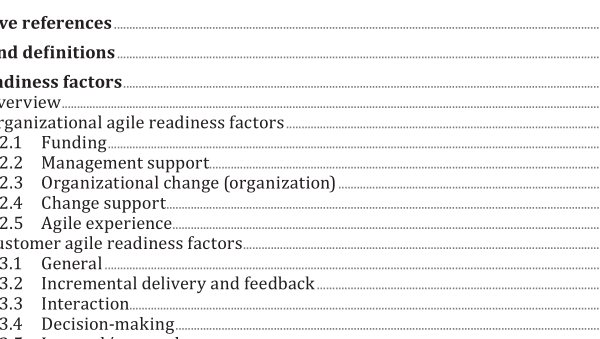ISO IEC TR 24587:2021 pdf download – Software and systems engineering — Agile development — Agile adoption considerations.
1 Scope This document provides an overview of agile readiness factors that are likely to determine whether an organization, project, product or team is ready to start the transition to using an agile approach to their system and software development and maintenance activities. This document provides a general approach that is applicable to all agile methodologies and does not cover specific agile methodologies, such as Scrum, SAFe and eXtreme Programming (XP). 2 Normative references There are no normative references in this document. 3? Terms? and? definitions For the purposes of this document, the following terms and definitions apply. ISO and IEC maintain terminology databases for use in standardization at the following addresses: — ISO Online browsing platform: available at https:// www .org/ obp — IEC Electropedia: available at https:// www .electropedia .org/ 3.1 agile development development approach based on iterative development (3.10), frequent inspection and adaptation, and incremental deliveries in which requirements and solutions evolve through collaboration in cross- functional teams and through continuous stakeholder (3.16) feedback Note 1 to entry: Any use of the word “agile” in this document refers to methodology. [SOURCE: ISO/IEC/IEEE 26515:2018, 3.1, modified — The reference to an external annex has been removed.] 3.2 agile maturity extent to which an organization, department, project or team consistently applies agile values and principles that contribute to the achievement of its business needs 3.3 agile team small cross-functional group of people who collaborate on the development of a product, within an agile methodology Note 1 to entry: A common agile team size is 3 to 10 people. 3.4 agile team lead individual responsible for ensuring an agile team (3.3) adheres to the organization’s agile principles, practices, values and processes Note 1 to entry: The agile team lead is a facilitator rather than a manager.
3.14 software feature software characteristic specified or implied by requirements documentation EXAMPLE Functionality, performance, attributes, design constraints. [SOURCE: ISO/IEC/IEEE 24765:2017, 3.3814] 3.15 sponsor person or group who provides resources and support for the project, program, or portfolio and is accountable for enabling success [SOURCE: ISO/IEC/IEEE 24765:2017, 3.3908] 3.16 stakeholder individual or organization having a right, share, claim, or interest in a system or in its possession of characteristics that meet their needs and expectations [SOURCE: ISO/IEC/IEEE 15288:2015, 4.1.44, modified — The example and note to entry have been deleted.] 3.17 taskboard visual display of tasks to be completed by an agile team (3.3) and recent progress made by the team 3.18 user story simple narrative illustrating a user requirement from the perspective of a persona (3.11) [SOURCE: ISO/IEC/IEEE 26515:2018, 3.16] 4 Agile readiness factors 4.1 Overview The agile readiness factors presented in this document have been derived for use by an organization that wants to determine their level of readiness to adopt an agile methodology for their system and software development. Use of these factors is not intended to provide a decision on whether to move to agile, rather it is to provide guidance on how to make the journey to agile easier. By considering these factors, an organization can gain an understanding of the main risks associated with transitioning into using an agile approach and the factors they need to consider when preparing to transition towards agile ways of working.
ISO IEC TR 24587:2021 pdf download – Software and systems engineering — Agile development — Agile adoption considerations






